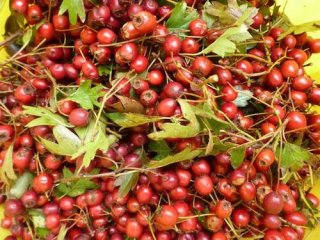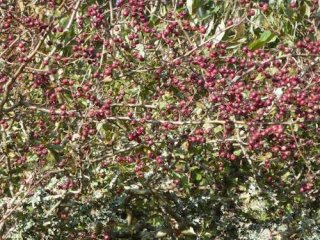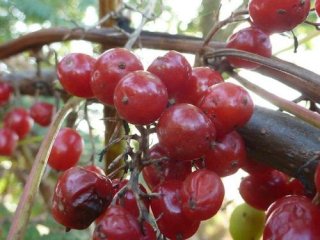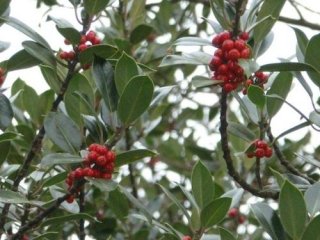
It seems as if there is a peripheral red haze at the edge of my vision at the moment – and though some may say that I have anger management issues, I know the truth is actually a wonderful crop of lustrous red berries this autumn. Last autumn was a premium one for blackberries and sloes, this year red is the vogue with wonderful displays of hawthorn, black bryony and holly.
 |
 |
 |
A bit of berry background - the botanical definition of a berry is a fleshy fruit produced from a single flower and containing one ovary. The berry is the most common type of fleshy fruit in which the entire ovary wall ripens into an edible pericarp. The seeds are usually embedded in the fleshy interior of the ovary. A plant that bears berries is said to be bacciferous or baccate (a fruit that resembles a berry, whether it actually is a berry or not, can also be called "baccate"). Many fruits that we lump together as berries may have a different internal structure and should be called drupes (eg blackthorn), pomes (eg hawthorns, apples) or aggregate fruits (blackberries and raspberries). For enlightenment on fruit categories here is a good starting point http://waynesword.palomar.edu/fruitid1.htm In everyday English, "berry" is a term for any small edible fruit. These "berries" are usually juicy, round, brightly coloured, sweet or sour, and do not have a stone or pit, although many seeds may be present. Berries are typically of a contrasting colour to their background (often of green leaves), making them visible and attractive to frugivorous animals and birds. This assists the wide dispersal of the plants' seeds.
Berry colours are due to natural plant pigments, many of which are polyphenols, such as the flavonoids, anthocyanins, and tannins, localized mainly in berry skins and seeds. Berries are often included amongst the 'superfoods', but although berry pigments have antioxidant properties there is no physiological evidence established to date that berry polyphenols have actual antioxidant functions within the human body. Consequently, it is not permitted to claim that foods containing polyphenols have antioxidant health value on product labels in the United States and Europe. (source Wikipedia )
HAWTHORN [Crataegus monogyna]. The red fruits have a large stone surrounded by a creamy-white flesh which is very slightly sweet, but frequently kicks in with a nasty after-taste. The berries can be used in conserves, and a haw berry wine is possible. Seek professional medical advice before consuming the berries if you have a cardiac or circulatory disorder. The hawthorn shrub has long sharp thorns in its lobed leaves, making its bushes a safe place for birds and small mammals to munch on the red berries away from predators. The berries are particularly attractive to small birds and thrushes which will become very defensive of individual shrubs later in the year as food sources like these become scarce. The one's that I have gathered will hopefully be germinated and grown on in our tree nursery to gap up hedgerows in a few years' time.
 BLACK BRYONY [Tamus communis] Abundant and poisonous. The only member of the yam family in the British Isles, common in England and Wales, scrambling over hedges and wood margins with heart shaped strikingly glossy leaves and bright shiny-red berries which often remain until mid-winter. The 'black' refers to the tubers which are also poisonous unless boiled. The berries can be fatal if eaten, though generally the effects are of an irritant purgative causing blistering of the skin and burning of the mouth.
BLACK BRYONY [Tamus communis] Abundant and poisonous. The only member of the yam family in the British Isles, common in England and Wales, scrambling over hedges and wood margins with heart shaped strikingly glossy leaves and bright shiny-red berries which often remain until mid-winter. The 'black' refers to the tubers which are also poisonous unless boiled. The berries can be fatal if eaten, though generally the effects are of an irritant purgative causing blistering of the skin and burning of the mouth.

HOLLY ( Ilex aquifolium) – outstanding berries - poisonous – but holly really deserves an article to itself. Other red berries you may chance upon at the moment are Spindle, Yew (poisonous), Butchers Broom and Rose hips (see below)
 |
 |
| Spindle | Yew |
 |
 |
| Butchers Broom | Rose hips |
There are plenty of red/reddish berries about – how about sharing yours on the facebook page https://www.facebook.com/LinkingtheLizard please?
Published: Oct 2014
Author: Steve Townsend
